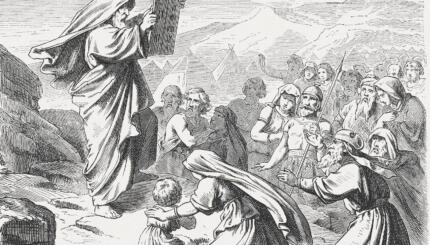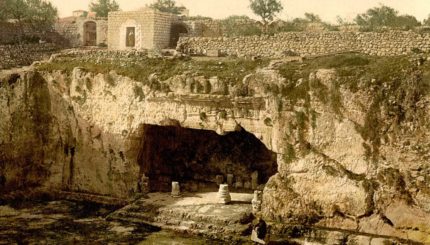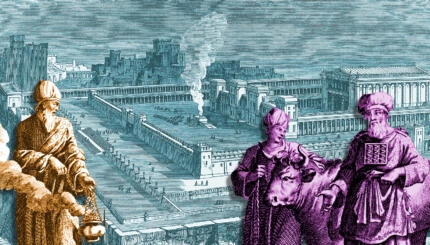Reprinted with permission from Eli Barnavi’s A Historical Atlas of the Jewish People, published by Schocken Books.
The Community Shifts Inland
When the Mamluks conquered Palestine [in 1260], destroyed the coastal towns, and eliminated the last vestiges of crusader rule, the map of Jewish settlements in the land was radically changed. With the disappearance of the Acre community, which until then had been the most prominent, the inland communities of Safed, and especially Jerusalem, took its place. Gaza and Hebron harbored smaller communities, and several Jewish villages remained on the Upper Galilee.
The Jewish villagers lived on agriculture, crafts, local trade and rural peddling; the city dwellers were artisans (weavers, saddlers, jewelers) and petty traders–mostly wine merchants–a trade prohibited to Muslims. Some European immigrants who specialized in what might be called a tourist industry supplied information, hostels, local products and money exchange to Christian pilgrims from their countries of origin.
A tradition of Jewish pilgrimage to holy places in the Galilee as well as in Jerusalem, which began in the Ayyubid period [1187-1189], continued to bring many visitors from all over the Eastern diaspora, particularly in the spring months between Passover and Shavuot (Pentecost)
With your help, My Jewish Learning can provide endless opportunities for learning, connection and discovery.
Cairo Was In Charge, Troubles Frequent
The leader of the Jews in the Mamluk state was the nagid (leader of the community) in Cairo. Nominally he stood at the top of a hierarchy ruling over the communities of the three provinces—Syria, Palestine and Egypt. A deputy leader represented the nagid in the provinces, first in Damascus and from 1376 in Jerusalem. In practice, however, the Palestinian communities during the Mamluk period were self-governing, and the title of deputy nagid was only honorary. The Mamluk authorities, fanatic and intolerant, harassed the Jewish population. At times there were outbreaks against the “protected people” followed by discriminatory legislation.
Immigration from the West continued regardless, but contacts with the source communities became extremely difficult after the collapse of the crusader state. Groups of scholars would prepare for aliyah to the Holy Land years before they undertook the journey itself, and on arrival in Palestine, they formed communes based on a division of labor: some worked to support the whole group, while other studied the Torah.
A Productive Meeting Place for Jewish Cultures
In the second half of the fourteenth century, Palestine (this time Jerusalem rather than Acre) once more became a meeting place for three Jewish cultures—Ashkenazi, Sephardi, and Oriental. After the Black Death and the anti-Jewish violence which erupted in its wake, a group of scholars from the Rhineland, inspired by messianic expectations, founded an Ashkenazi yeshivah in Jerusalem that was active at least until the end of that century. Spanish Jews arriving at the same time were soon joined by Jewish intellectuals from Muslim countries and from Byzantium. Dozens of manuscripts produced in Jerusalem towards the end of the fourteenth century, some original and some copies of older works, on Halakhah [Jewish law], Spanish Kabbalah [mysticism], Ashkenazi mysticism, and philosophy, attest to the rich blend of cultural life in this city.
Messianism Fed Immigration
In 1392, the anti-Jewish outbreaks in Spain, the fall of Constantinople in 1453, and the frequent expulsions from German cities formed an accumulation of disasters, which aroused messianic tensions in Jewish society. The liquidation of the Byzantine Empire, for example, led many Jews who had suffered its persecutions and intolerance to believe that the end of Christianity was imminent. Such spiritual fermentation resulted in a continuous trickle of emigration from Europe to the Land of Israel.
Those who announced their intention to “ascend” to the Holy Land enjoyed a privileged status within their communities, as these felt an obligation to support such devoted members. Nevertheless, when they came to Palestine, these immigrants, who in many cases were the religious elite in their former communities, encountered hostility on the part of the parnasim–the native secular leaders of the local communities–who were afraid of losing their authority.
Towards the end of the Mamluk period, and particularly after the expulsion from Spain in 1492, it was the Spanish immigration (enthusiastically encouraged by the last nagid, Isaac ha-Kohen Sholal) which made its mark on Palestinian Jewry. Like all other communities in the Ottoman Empire, the community in the Land of Israel would be a predominantly Sephardi community until the nineteenth century.
Ashkenazi
Pronounced: AHSH-ken-AH-zee, Origin: Hebrew, Jews of Central and Eastern European origin.
Kabbalah
Pronounced: kah-bah-LAH, sometimes kuh-BAHL-uh, Origin: Hebrew, Jewish mysticism.
Shavuot
Pronounced: shah-voo-OTE (oo as in boot), also shah-VOO-us, Origin: Hebrew, the holiday celebrating the giving of the Torah at Mount Sinai, falls in the Hebrew month Sivan, which usually coincides with May or June.


